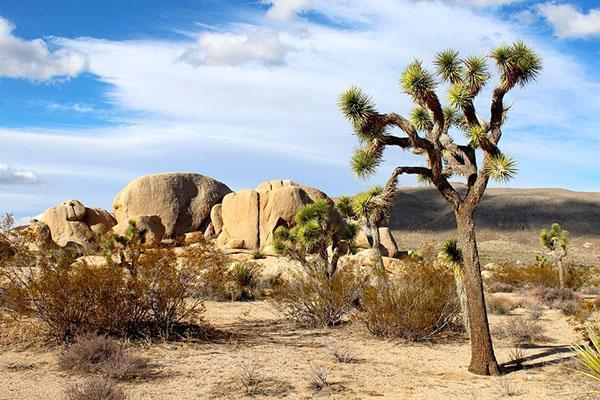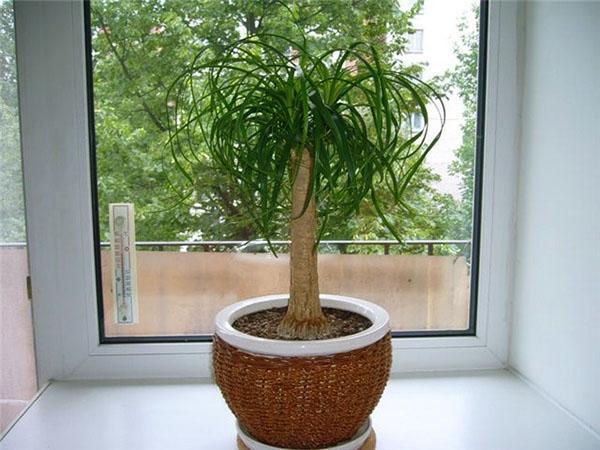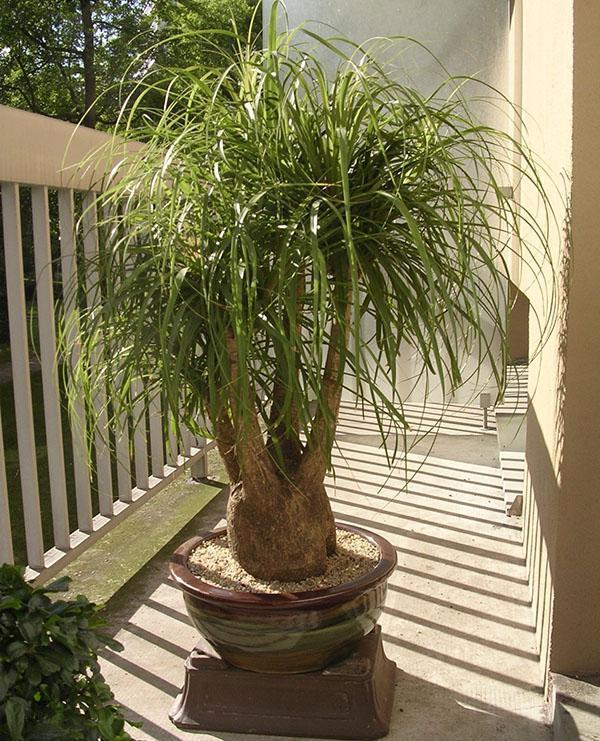Exotic plant bokarnea - nolina or bottle palm
 The average Russian resident knows little about the flora of the southern United States, Mexico, and other regions of Central America. And what can grow on the endless expanses of the prairies, where the soil scorched by the sun and the blocks of sandstone rolled by the wind to the horizon?
The average Russian resident knows little about the flora of the southern United States, Mexico, and other regions of Central America. And what can grow on the endless expanses of the prairies, where the soil scorched by the sun and the blocks of sandstone rolled by the wind to the horizon?
But it turns out that here, in addition to stunted thorns and shrubs, you can see a lot of interesting things, for example, an amazing exotic plant, bokarneu or nolina, as botanists call it today. The name change was caused by a more complete and accurate study and description of the culture than the previous ones.
Initially, the bokarnei were recognized as species related to agaves, but according to the modern classification they are included in the Asparagus family and within the genus are combined with the nolins.
According to the latest data, there are about 30 independent species in the genus, the representatives of which are correctly called nolins, but in the literature there is also an old name familiar to flower growers.
Despite the similar natural conditions in which wild specimens grow, representatives of different species are strikingly different from each other. At home, the bokarnea plant can look like a powerful tree with a thickened trunk and a developed crown. But there are varieties in which only a cap of narrow, rigid foliage is visible above the ground.

In fact, such an appearance is not a freak of nature, but a necessity and a very important adaptation that helps a culture to survive. At home, bokarnei plants are forced to fight for every drop of moisture.
In the arid regions of Central America, nolins accumulate water in the thickened lower part of the stem. And the tough, pointed foliage, more like cereals, prevents excessive evaporation of moisture from the crown.
Reproduction of bokarnei at home
 The original appearance of the culture attracted the attention of lovers of ornamental plants. But the slow-growing Central American isn't too cheap. To become the owner of the coveted "bottle tree", you can try to propagate the plant by obtaining seedlings from seeds or by rooting a lateral shoot from an adult specimen.
The original appearance of the culture attracted the attention of lovers of ornamental plants. But the slow-growing Central American isn't too cheap. To become the owner of the coveted "bottle tree", you can try to propagate the plant by obtaining seedlings from seeds or by rooting a lateral shoot from an adult specimen.
Bokarnea seeds:
- treated with a weak solution of potassium permanganate;
- laid out on a wet sand-peat mixture;
- gently pressed into the ground and slightly mulched with the same composition.
In the warmth, under glass, the seeds spend about 2-3 weeks until the first shoots appear. All this time and subsequently, seedlings of nolina or bokarnea need to moisten the substrate and illuminate to ensure a day of light lasting at least 12-14 hours.
If there are lateral shoots on an adult nolina, they can also be used to obtain a young generation of plants. The root system of this culture is superficial and not too powerful, but for its formation it is important to cut the cutting as close to the main stem as possible.
- Most of the foliage is removed from the tip of the shoot.
- The cut of the appendix is first dipped in powder from charcoal or activated carbon, then dried.
- Cuttings prepared in this way are planted, slightly deepening, into a substrate of peat, sand and a small amount of sphagnum.
In the greenhouse, with regular, but not abundant watering, the shoots are until complete rooting, then they are transplanted into conditions for adult plants.
The ease of home maintenance and the original appearance have become the reasons that some types of bokarnea or nolina are extremely popular indoor plants. Unlike their wild-growing counterparts, they cannot reach their natural size, and also rarely bloom, but this does not detract from the attractiveness of an exotic plant.
Beaucarnea or Nolina parryi
 Bocarnea parryi is not the largest representative of the genus, its height reaches 1–2 meters, while deformation of the top of the plant can form two or more rosettes of leaves. Green or gray, hard foliage has serrated edges and grows in length up to 50–120 cm. The width of the leaf plate is much smaller and does not exceed 2–4 cm.
Bocarnea parryi is not the largest representative of the genus, its height reaches 1–2 meters, while deformation of the top of the plant can form two or more rosettes of leaves. Green or gray, hard foliage has serrated edges and grows in length up to 50–120 cm. The width of the leaf plate is much smaller and does not exceed 2–4 cm.
At home, the Parry bokarnea plant blooms, forming large racemose inflorescences up to 1.2 to 4 meters long. The flowers are small, about 0.3–0.5 cm in diameter, and are white, pinkish or yellowish in color. Flowering occurs from April to June.
Plants of this species, like many bokarnei, are cold-resistant. In California, where Nolina Parry lives in the wild, she tolerates temperatures down to –10 ° C.
Bocarnea or Nolina Guatemalan (Beaucarnea, Nolina guatemalensis)
 Bocarnea guatemalensis, or Guatemalan tail, is one of the tallest plant species, which in nature can reach five meters in height. Like other varieties, the trunk of this nolina actively accumulates moisture and expands with age. In the lower part, the girth of such a specimen sometimes reaches 4 meters.
Bocarnea guatemalensis, or Guatemalan tail, is one of the tallest plant species, which in nature can reach five meters in height. Like other varieties, the trunk of this nolina actively accumulates moisture and expands with age. In the lower part, the girth of such a specimen sometimes reaches 4 meters.
A characteristic feature is long, ribbon-like leaves, strongly tapering towards the ends. At the disposal of florists there are varieties of bokarnei, as in the photo, with leaves decorated with light stripes at the edges.
Bocarnea, nolina thin (Beaucarnea, Nolina gracilis)
 The bokarnea or nolina variety, popular among indoor plant lovers, has earned recognition due to its pronounced convex shape of the trunk. The name of the species translates as thin or slender, but this is more of a joke!
The bokarnea or nolina variety, popular among indoor plant lovers, has earned recognition due to its pronounced convex shape of the trunk. The name of the species translates as thin or slender, but this is more of a joke!
 Nolina gracilis is one of the most outstanding plump women in the genus and in the entire plant kingdom. As the culture grows, the trunk at the base becomes very voluminous and reaches 5–7 meters in girth.
Nolina gracilis is one of the most outstanding plump women in the genus and in the entire plant kingdom. As the culture grows, the trunk at the base becomes very voluminous and reaches 5–7 meters in girth.
 The crown represents thick bunches of leaves up to 70 cm long. Flowering can be seen only in the homeland of the plant, the bokarney of this species blooms only in adulthood, unattainable at home.
The crown represents thick bunches of leaves up to 70 cm long. Flowering can be seen only in the homeland of the plant, the bokarney of this species blooms only in adulthood, unattainable at home.
Beaucarnea, Nolina lindheimeriana
 Not all bokarnei are tall. Nolina Lindemeira, referred to by the local population as a damn lace, has practically no trunk, and only extremely strong, tough leaves are visible above the ground.
Not all bokarnei are tall. Nolina Lindemeira, referred to by the local population as a damn lace, has practically no trunk, and only extremely strong, tough leaves are visible above the ground.
Beaucarnea, Nolina longifolia
 Mexican herb tree, so long-leaved nolina is called in areas where it occurs in nature. A large bokarnea plant, as in the photo, turns with age into a branched multi-meter tree, whose trunk is covered with a dense cork layer of bark.
Mexican herb tree, so long-leaved nolina is called in areas where it occurs in nature. A large bokarnea plant, as in the photo, turns with age into a branched multi-meter tree, whose trunk is covered with a dense cork layer of bark.
 A native of Mexico, long-leaved bokarnea or Nolina longifolia, has a powerful upright trunk with a thickening characteristic of a plant of this genus in the root part. Hard, hanging leaves are located at the apical part. Over time, the old foliage dries up and turns into a kind of skirt that covers the trunk almost to the ground.
A native of Mexico, long-leaved bokarnea or Nolina longifolia, has a powerful upright trunk with a thickening characteristic of a plant of this genus in the root part. Hard, hanging leaves are located at the apical part. Over time, the old foliage dries up and turns into a kind of skirt that covers the trunk almost to the ground.
Beaucarnea or Nolina Nelson (Beaucarnea, Nolina nelsonii)
Blue nolina or intervez grass, as Nelson's sideworm is called in northwestern Mexico. A frost-hardy, unpretentious bokarnea variety, as shown in the photo, was discovered in the desert mountainous regions of Tamaulipas and was later described in 1906. The plant is not afraid of cold down to –12 ° С.
 Nolina nelsonii is distinguished by bluish-green leaves with a dense serrate edge and up to 70 cm long. The leaves are hard, sticking out in different directions. The plant itself can reach a height of 1.5–3 meters.
Nolina nelsonii is distinguished by bluish-green leaves with a dense serrate edge and up to 70 cm long. The leaves are hard, sticking out in different directions. The plant itself can reach a height of 1.5–3 meters.
The appearance of flowers on this bokarnea variety is observed in the spring. After flowering, several lateral trunks are formed on the plant, subsequently replacing the main one.
The trunk of young specimens of this nolina is almost invisible. It can be observed only in mature plants that have lost more than one row of foliage in the root zone.
Nolina, bent bent (Beaucarnea, Nolina recurvata)
 The native land of the bokarnea recurvata plant, popularly known as the elephant's foot or bottle palm, is the state of Tamaulipas, Veracruz and San Luis Potosi in eastern Mexico. The species has been most studied and domesticated in the second half of the 19th century. In Mexico, botanists have discovered the oldest specimens of the bokarnea, about 350 years old.
The native land of the bokarnea recurvata plant, popularly known as the elephant's foot or bottle palm, is the state of Tamaulipas, Veracruz and San Luis Potosi in eastern Mexico. The species has been most studied and domesticated in the second half of the 19th century. In Mexico, botanists have discovered the oldest specimens of the bokarnea, about 350 years old.
 Bokarnea bent or nolina recurvata in nature grows on a par with the largest trees. An adult specimen may be 6–8 m high, but in a pot culture, the maximum size is much more modest, only one and a half meters. However, this does not affect the amazing beauty of the plant. Bocarnea will decorate even the most modest interior of the room.
Bokarnea bent or nolina recurvata in nature grows on a par with the largest trees. An adult specimen may be 6–8 m high, but in a pot culture, the maximum size is much more modest, only one and a half meters. However, this does not affect the amazing beauty of the plant. Bocarnea will decorate even the most modest interior of the room.
In addition to the trunk in the shape of a bulky bottle, the plant is easily recognizable by the long leaves hanging from the apical rosettes. Green leaf plates up to a meter long in some varieties can be crimped.
 In indoor conditions, bokarnei do not bloom, and nolina recurvata is no exception. But in the homeland, lush, appearing in summer, paniculate inflorescences of a plant are not uncommon. The largest specimens of bokarnea are bent and their flowering can be seen in greenhouses, where plants quickly adapt and coexist with agaves and yuccas.
In indoor conditions, bokarnei do not bloom, and nolina recurvata is no exception. But in the homeland, lush, appearing in summer, paniculate inflorescences of a plant are not uncommon. The largest specimens of bokarnea are bent and their flowering can be seen in greenhouses, where plants quickly adapt and coexist with agaves and yuccas.
Nolina, bokarnea compressed (Beaucarnea, Nolina stricta)
 Nolina or bokarnea compressed lives in the central regions of Mexico. The plant has a powerful stem, shaped like an earthen vessel or bottle. The leaves, like all related species, are narrow and very tough. In their homeland, bokarnei plants of this species can withstand frosts down to –5 ° C, easily tolerate long dry periods and do not suffer from an abundance of sun.
Nolina or bokarnea compressed lives in the central regions of Mexico. The plant has a powerful stem, shaped like an earthen vessel or bottle. The leaves, like all related species, are narrow and very tough. In their homeland, bokarnei plants of this species can withstand frosts down to –5 ° C, easily tolerate long dry periods and do not suffer from an abundance of sun.
Nolina, bokarneya microcarpa (Beaucarnea, Nolina Microcarpa)
One of the most eagerly flowering species of bokarnea is found in northern Mexico and the southwestern United States. Locals call this relatively low herbaceous plant Sacahuista or Beagrass. The rosette of coarse thin serrated leaves grows in width to two meters. Separate leaf plates of bokarnei, in the photo, grow up to 130 cm in length.
 Unlike other species, nolina microcarp does not have an aboveground trunk, the entire lignified part is located under the surface of the soil. During flowering, in addition to paniculate inflorescences consisting of small white-yellow flowers, the plant forms characteristic curling antennae up to 1.5-1.8 meters in length.
Unlike other species, nolina microcarp does not have an aboveground trunk, the entire lignified part is located under the surface of the soil. During flowering, in addition to paniculate inflorescences consisting of small white-yellow flowers, the plant forms characteristic curling antennae up to 1.5-1.8 meters in length.
Hello!
I am looking on the Internet, how can I save my nolina, which suddenly began to wither. I saw useful information on your site, but I would like to receive advice and specific recommendations from specialists specifically for my situation.
I picked up Nolina as an adult tree in a very bad frostbitten condition in the garbage dump of a flower shop in the winter 4-5 ago. She came to life with me, she felt good, long beautiful leaves grew, she stood green and cheerful. And about a month ago, I began to notice that the nolina began to wither somehow, the adult leaves began to turn yellow from the root, and the young ones on the tops became very thinned, crushed, noticeably thinned and seemed to break not far from the base. It is clearly visible that she feels bad ... that she is downright dying ... (((((
I do not know what to do, what to do right now to prevent the plant from dying and to heal it.
I really ask you for the urgent help of experienced florists to save my Nolina!
The process of drying out of adult leaves with their further dropping is quite natural for nolina. They just have to be cut. As for the young foliage, their pale appearance and loss of elasticity may indicate a lack of moisture. If the soil in the pot is constantly wet, check the condition of the roots. Perhaps, due to some disease, they were damaged and simply cannot supply water from the soil to the very top to the leaves. High temperatures or lack of light can cause the leaves to shrink and become brittle. Try replanting nolin in new soil, changing the place and feeding with fertilizers. If the situation does not change, you can cut and root the top to completely renew the plant.
Thanks, I'll try)
And how to properly cut and root the plant, if that?
Rooting the top of the nolina is similar to the dracaena. Cut off the top of the plant as close to the stem as possible. If you plan to leave your leg for now, be sure to sprinkle the cut with charcoal. It is not uncommon for sleeping lateral buds to wake up on the main trunk left after pruning. Remove the bottom row of leaves at the tops and leave for a couple of hours to dry. Then plant it in nutritious light soil, crushing the ground around a little. Cover with plastic wrap and place in a bright, warm place. Periodically, the greenhouse must be ventilated, but it will be possible to remove it only after new shoots appear.
Thank you so much))